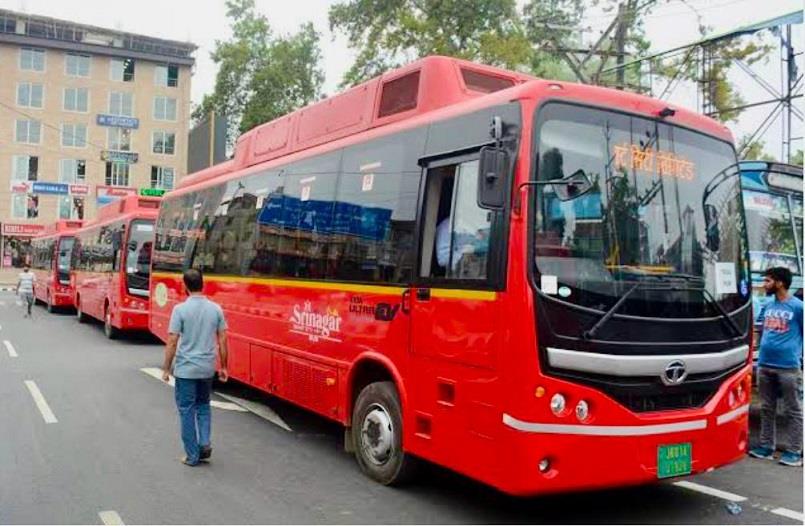The Daily Struggle Of Kashmiri Women On Smart City Buses
File photo of Smart City Electric Bus
At 8:30 every morning, Rafia stands near Lal Chowk, a central square in Srinagar, watching the familiar line of Smart City buses roll in.
Her schoolbag hangs over one shoulder, her eyes flitting across the crowd, calculating the odds of squeezing in without confrontation.
The air, already heavy with humidity, seems to pulse with tension as commuters press closer.
The bus doors open. A wave of bodies surges forward. She steps in, arms close to her sides, gripping her bag as though it's a shield.
The smell of sweat rises, voices murmur.
Today, a man mutters something about women“taking over” the bus. Rafia stiffens, her face unreadable.
She learned early on that survival meant looking past these remarks.
Rafia is not alone. Her story has become part of a larger narrative unfolding in Srinagar, a city where public transport once symbolized despair for women and now, after a bold government move, has become an arena of cultural friction.
In April this year, the local government waived bus fares for women, a decision hailed as progressive. The idea was simple: free travel would empower women to pursue education, jobs, and social engagement.
At first, the change felt empowering. Saima, 23, a graduate student, recalled how the new buses were a relief.“Before, I avoided buses,” she said.“The old public transport was filthy, unsafe. You never knew what to expect.”
For the first time, she felt a sense of control over her commute.
Zeenat, a 35-year-old marketing professional, remembers the first time she boarded a Smart City bus without fear.“It was like a small victory,” she said.“The space was organized, calm. I could sit without worrying about being harassed.”
But as the months passed, the promise of safety began to erode.
The decision to make rides free drew a sharp response from many men, who perceived it as an infringement on their space.
Overcrowding worsened. The number of female commuters doubled, according to the Srinagar Municipal Corporation, while the fleet expanded only marginally.
Instead of adding new buses, some were reallocated from urban routes to suburban services, squeezing the system further.
In the narrow corridors of a packed Smart Bus, personal space vanished. Men jostled past women in anger or indifference. Saima described her daily ride as“negotiating space.”
“Some days,” she said,“it feels like I have to prove I deserve to be here.”
Zeenat's approach is more direct.
Last week, near Lal Chowk, she confronted a group of older men shouting at women boarding the bus.“They acted like their age gave them a right,” she said.“I told them, 'This bus is for women. I won't tolerate your harassment.'”
The men recoiled, startled by her defiance.
At Dalgate, a protest stirred controversy. A young man walked out, complaining that the packed buses caused“inconvenience.”
The protest was less about logistics and more about perceived entitlement, a reaction to a policy designed to level opportunity.
For Rafia, the Smart City bus is a lifeline. Her days stretch long, teaching at a government school and returning home with fatigue etched in her face. Skipping the bus isn't an option.
Alternatives are costlier or unreliable. The old 407s remain crowded, unregulated, and a source of dread.
Former SMC Commissioner Athar Aamir Khan, the then-CEO of the Smart City Project, had described the fleet as a“commitment to safety.” In early days, that promise seemed real.
But now, cameras that once symbolized oversight stand powerless when bodies press shoulder to shoulder. Panic buttons lie out of reach. The fleet has become a mirror of the old chaos.

Legal Disclaimer:
MENAFN provides the
information “as is” without warranty of any kind. We do not accept
any responsibility or liability for the accuracy, content, images,
videos, licenses, completeness, legality, or reliability of the information
contained in this article. If you have any complaints or copyright
issues related to this article, kindly contact the provider above.
Most popular stories
Market Research

- Nutritional Bar Market Size To Expand At A CAGR Of 3.5% During 2025-2033
- North America Perms And Relaxants Market Size, Share And Growth Report 2025-2033
- Primexbt Wins Global Forex Award For Best Multi-Asset Trading Platform
- Smart Indoor Gardens Market Growth: Size, Trends, And Forecast 20252033
- Excellion Finance Scales Market-Neutral Defi Strategies With Fordefi's MPC Wallet
- Japan Green Hydrogen Market Size To Reach USD 734 Million By 2033 CAGR Of 27.00%






















Comments
No comment